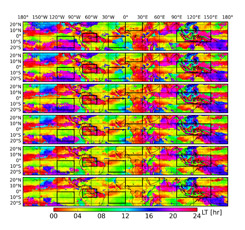Diurnal Variation of Tropospheric Relative Humidity in Tropical Regions
Submitter: Isaac Moradi, ESSIC, University of Maryland, NASA/GSFC/GMAO
Area of Research: Atmospheric water vapor
GEWEX Panel: GEWEX Data and Assessments Panel (GDAP)
Journal Reference:
Moradi, I., P. Arkin, R. Ferraro, P. Eriksson, and E. Fetzer, 2016. Diurnal variation of tropospheric relative humidity in tropical regions. Atmos. Chem. Phys., 16, 6913-6929, doi:10.5194/acp-16-6913-2016.
Science:
Measurements from the SAPHIR onboard Megha-Tropiques are used to evaluate the diurnal cycle of tropospheric humidity in the tropical region. The results show a large inhomogeneity in the amplitude and peak time of tropospheric humidity. The diurnal amplitude tends to be larger over convective regions than over subsidence regions. An early morning peak time is observed over most regions but there are substantial regions where the diurnal peak occurs at the other times of day.
Impact:
The results of this study can be used to evaluate the simulations of tropospheric humidity in the models or other data sets such as diurnal cycle of relative humidity in reanalyses.
Summary:
Despite the importance of water vapor especially in the tropical region, the diurnal variations of water vapor have not been completely investigated in the past due to the lack of adequate observations. Measurements from Sondeur Atmosphérique du Profil d’Humidité Intertropicale par Radiométrie (SAPHIR) onboard the low inclination Megha-Tropiques satellite with frequent daily revisits provide a valuable dataset for investigating the diurnal and spatial variation of tropospheric relative humidity in the tropical region. In this study, we first transformed SAPHIR observations into layer-averaged relative humidity, then partitioned the data based on local observation time into 24 bins with a grid resolution of one degree. Afterwards, we fitted Fourier series to the binned data. Finally, the mean, amplitude, and diurnal peak time of relative humidity in tropical regions were calculated for each grid point using either the measurements or Fourier series. The results were separately investigated for different SAPHIR channels as well as for relative humidity with respect to both liquid and ice phases. The results showed that the wet and dry regions are, respectively, associated with convective and subsidence regions which is consistent with the previous studies. The mean tropospheric humidity values reported in this study are generally 10 to 15 % higher than those reported using infrared observations which is because of strict cloud screening for infrared measurements. The results showed a large inhomogeneity in diurnal variation of tropospheric relative humidity in tropical region. The diurnal amplitude was larger over land than over ocean and the oceanic amplitude was larger over convective regions than over subsidence regions. The results showed that the diurnal amplitude is less than 10 % in middle and upper troposphere, but it is up to 30 % in lower troposphere over land. Although the peak of RH generally occurs over night or in early morning, there are several regions where the diurnal peak occurs at other times of the day. The early morning peak time is because of a peak in convective activities in early morning. Additionally, a double peak was observed in tropospheric humidity over some regions, which is consistent with double peak in precipitation.
Link to the Original Research Publication or Website:
http://www.atmos-chem-phys.net/16/6913/2016/acp-16-6913-2016.html


